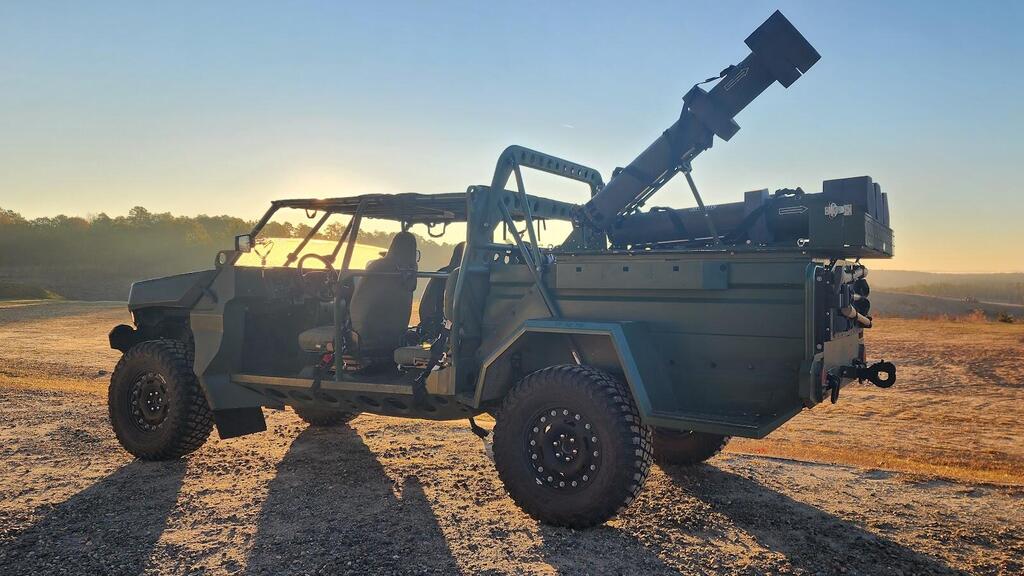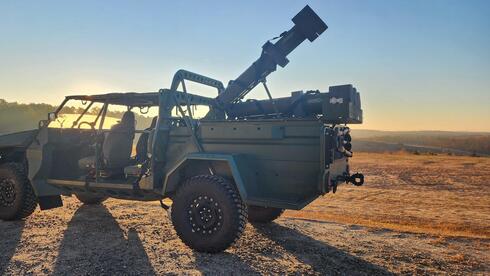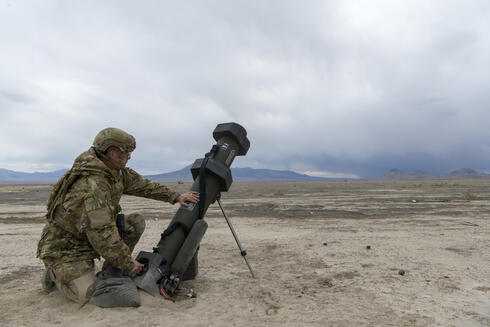
“Our drone is a one-way ticket”: Inside UVision’s deadly marriage of surveillance and strike
As part of CTech’s series on Israel’s unmanned aerialscape, UVision EVP Itzik Huber explains how loitering munitions merge the intelligence of UAVs with the strike power of missiles, and the way that combination is reshaping modern warfare.
“Software is the highlight of UAVs,” said Itzik Huber, EVP of Strategy and Business Development at UVision.
“The big changes are happening in the software capability. It’s no longer a single point of operation that the operator operates the UAV, but more a swarm capability, a group flying in the air, collecting the information for itself, talking with itself, changing the mission according to the situation.”
Propelled by modern warfare, from the Russia-Ukraine war to Israel’s more recent war against Hamas and conflict with Iran, the capabilities of the rapidly maturing drone industry have been cast into unprecedented focus. From defense powerhouses to specialized platforms, from AI-driven intelligence to counter-drone systems, the unmanned aerial landscape represents one of the most dynamic areas of defense technology.
In this series, CTech speaks with the companies driving Israel’s Unmanned Aerial Vehicles and Systems sector to map the industry, and the challenges and opportunities ahead.
Founded in Israel in 2011, UVision specializes in loitering aerial munition systems; a class of unmanned aerial solutions far removed from the quadcopters that often dominate public perception of UAVs.
Huber, an Israeli Air Force veteran who has built an extensive career in the drone industry, is today based in UVision’s U.S. branch.
With its flagship HERO family of fixed-wing and rotary loitering munition systems, UVision produces “a combination of what used to be two different capabilities,” he explained to CTech. “One of them was to identify and prioritize the target, the other one was to attack the target.
“On one side, it flies like a UAV, loiter like a UAV, searches for targets like a UAV. On the other hand, it's fully capable as a missile, and can directly attack targets that you choose or prioritize and finish the attack mission by itself.”
Further to what distinguishes loitering munitions within the broader “drone” family is that, unlike traditional UAVs such as the quadcopter (which has become largely synonymous with the term) UVision’s munitions are not built to return to base. “Normal UAVs are reusable,” said Huber. “Our drone is a one-way ticket.”
Israel as testbed
Although UVision operates globally, with four entities around the world, it remains headquartered in Israel. And while competitors exist, Huber argues, they remain relatively few. “The competitors we see are companies like AV (AeroVironment), or WB \[Group\] in Poland. There are not many in this market, and each competitor finds a bit of a different solution… But we have differentiators that specify our munition as a better munition in this space.”
For UVision, a significant differentiator advantage against its international competitors, Huber argues, comes from the uniqueness of Israel itself. “We… have two major advantages over the rest of the world,” said Huber. “One of them, unfortunately, is that we have a lot of conflicts in different arenas. So we get the operational knowledge and operational debriefing very fast and very efficiently.”
The second factor, he continued, is not only the environment in which the product is forged but also the minds behind its development; the workforce. “The next advantage that we have is the manpower… the world sees us as people that know what they're talking about.”
“We have the manpower and managers that come from the field… but we also have the technological and engineering side that is very big and can implement the ideas.”
“It’s a combination of knowledge and practical capabilities that we brought from the service but also from other companies and universities. And I think the rest of the companies in Israel are like that.”
And finally, the geography of the country itself plays a role in the innovation that Israel’s UAV industry, including its loitering munitions, has witnessed and benefited from.
“Israel is the best playground,” concluded Huber. “It's small, it's very condensed. If you fly an F-16 in Israel, if you turn around Tel Aviv, you finish the turn in the Dead Sea… The condensed area of Israel is excellent for training and operation in that field. And from that, we learn a lot.”
Lessons from the frontline
Recent conflicts, including the Israel-Hamas war and the situation with Iran, have had a two-way effect, both demonstrating the relevance of loitering munitions on the battlefield and feeding lessons back into the development process.
“We have a lot of knowledge coming back from the operational side,” said Huber. “Then we adjust and change what needs to be changed to better support the operators.”
At the same time, the conflicts have accelerated demand and visibility for loitering munitions, propelling what was once, Huber described, “a niche solution,” into a more mainstream option as a “cost-effective, efficient, with low collateral damage solution,” for “things like border protection, naval protection… anyone that needs to protect an area or to protect his soldiers and do some far away attacks to an adversary.”
The conflicts “did a few different things,” said Huber. “One of them is, of course, to demonstrate the capability and to open the eyes of operators around the world and decision making around the world to that capability that was not popular or well known five or six years ago.”
“In these conflicts, they came to learn what is the big flexibility of UAV, what variety of missions you can do with drones or loitering ammunition. And once they understand that, it opens their own minds.”
Related articles:
The software frontier and swarm capability
Looking ahead in both the field of UAVs in general, and loitering munitions in particular, Huber sees the next great growth engine for the industry as software, which he described as showing “a big jump” as it moves toward realizing the promise of swarm operations.
“Everything that you've seen in the software developments of the last few years, mainly AI and decision-making capability, is getting into the UAV. So they're getting smarter and smarter.”
For UVision, this evolution toward smarter software means loitering munitions that can share information and adapt in real time, ultimately easing pressure on human operators. “What you see in the popular world with ChatGPT and Google is immediately transformed to AI and other artificial intelligence capabilities on the munition itself,” said Huber.
“That means mainly to reduce the workload of the one person that operates the system… and maybe from time to time, even take the right decision by the automatic system itself.”
an extensive career in the drone industry, is today based in UVision’s U.S. branch.With its flagship HERO family of fixed-wing and rotary loitering munition systems, UVision produces “a combination of what used to be two different capabilities,” he explained to CTech. “One of them was to identify and prioritize the target, the other one was to attack the target.
“On one side, it flies like a UAV, loiter like a UAV, searches for targets like a UAV. On the other hand, it's fully capable as a missile, and can directly attack targets that you choose or prioritize and finish the attack mission by itself.”
Further to what distinguishes loitering munitions within the broader “drone” family is that, unlike traditional UAVs such as the quadcopter (which has become largely synonymous with the term) UVision’s munitions are not built to return to base. “Normal UAVs are reusable,” said Huber. “Our drone is a one-way ticket.”
Israel as testbed
Although UVision operates globally, with four entities around the world, it remains headquartered in Israel. And while competitors exist, Huber argues, they remain relatively few. “The competitors we see are companies like AV (AeroVironment), or WB \[Group\] in Poland. There are not many in this market, and each competitor finds a bit of a different solution… But we have differentiators that specify our munition as a better munition in this space.”
For UVision, a significant differentiator advantage against its international competitors, Huber argues, comes from the uniqueness of Israel itself. “We… have two major advantages over the rest of the world,” said Huber. “One of them, unfortunately, is that we have a lot of conflicts in different arenas. So we get the operational knowledge and operational debriefing very fast and very efficiently.”
The second factor, he continued, is not only the environment in which the product is forged but also the minds behind its development; the workforce. “The next advantage that we have is the manpower… the world sees us as people that know what they're talking about.”
“We have the manpower and managers that come from the field… but we also have the technological and engineering side that is very big and can implement the ideas.”
“It’s a combination of knowledge and practical capabilities that we brought from the service but also from other companies and universities. And I think the rest of the companies in Israel are like that.”
And finally, the geography of the country itself plays a role in the innovation that Israel’s UAV industry, including its loitering munitions, has witnessed and benefited from.
“Israel is the best playground,” concluded Huber. “It's small, it's very condensed. If you fly an F-16 in Israel, if you turn around Tel Aviv, you finish the turn in the Dead Sea… The condensed area of Israel is excellent for training and operation in that field. And from that, we learn a lot.”
Lessons from the frontline
Recent conflicts, including the Israel-Hamas war and the situation with Iran, have had a two-way effect, both demonstrating the relevance of loitering munitions on the battlefield and feeding lessons back into the development process.
“We have a lot of knowledge coming back from the operational side,” said Huber. “Then we adjust and change what needs to be changed to better support the operators.”
At the same time, the conflicts have accelerated demand and visibility for loitering munitions, propelling what was once, Huber described, “a niche solution,” into a more mainstream option as a “cost-effective, efficient, with low collateral damage solution,” for “things like border protection, naval protection… anyone that needs to protect an area or to protect his soldiers and do some far away attacks to an adversary.”
The conflicts “did a few different things,” said Huber. “One of them is, of course, to demonstrate the capability and to open the eyes of operators around the world and decision making around the world to that capability that was not popular or well known five or six years ago.”
“In these conflicts, they came to learn what is the big flexibility of UAV, what variety of missions you can do with drones or loitering ammunition. And once they understand that, it opens their own minds.”
Related articles:
The software frontier and swarm capability
Looking ahead in both the field of UAVs in general, and loitering munitions in particular, Huber sees the next great growth engine for the industry as software, which he described as showing “a big jump” as it moves toward realizing the promise of swarm operations.
“Everything that you've seen in the software developments of the last few years, mainly AI and decision-making capability, is getting into the UAV. So they're getting smarter and smarter.”
For UVision, this evolution toward smarter software means loitering munitions that can share information and adapt in real time, ultimately easing pressure on human operators. “What you see in the popular world with ChatGPT and Google is immediately transformed to AI and other artificial intelligence capabilities on the munition itself,” said Huber.
“That means mainly to reduce the workload of the one person that operates the system… and maybe from time to time, even take the right decision by the automatic system itself.”

